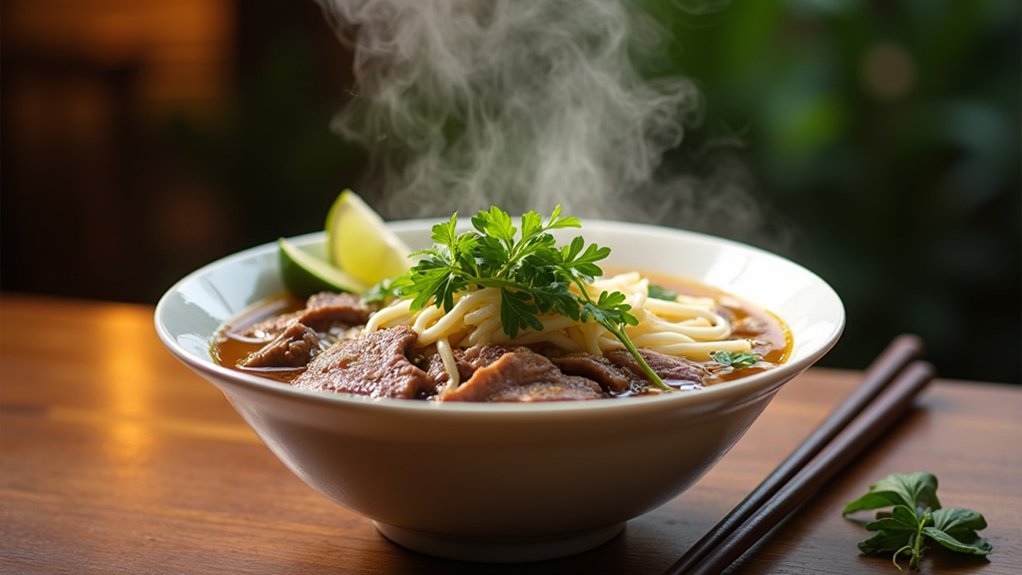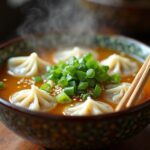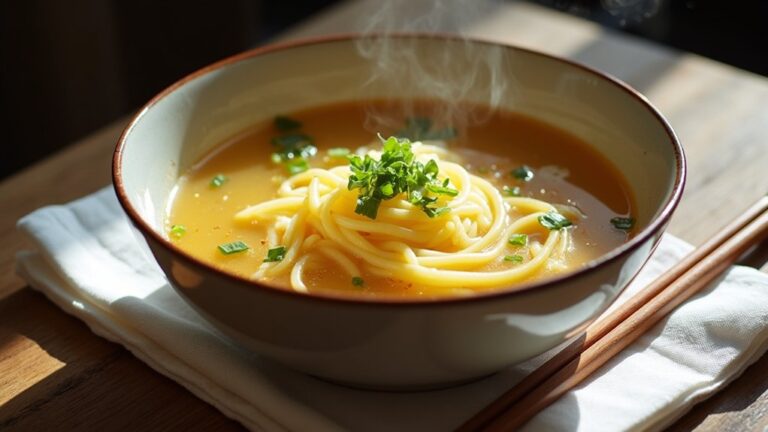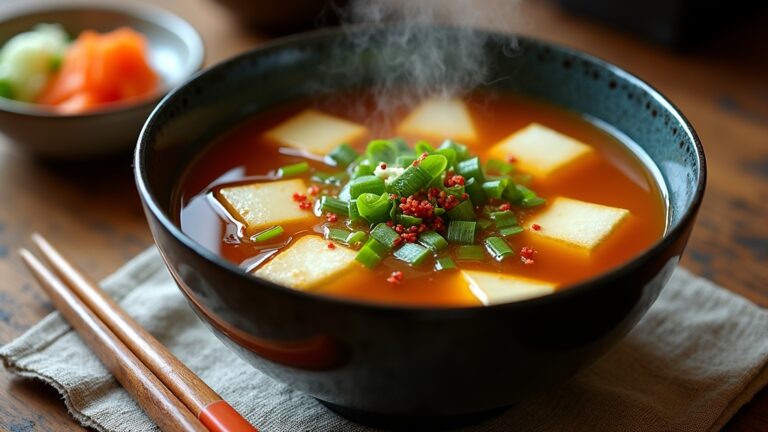Pho Soup Recipe
Pho soup is a delightful Vietnamese dish that I adore. It starts with a rich, fragrant broth simmered for hours, filled with spices like star anise and cinnamon. I love adding slippery rice noodles and choosing my protein, whether beef or chicken. Fresh herbs like basil and cilantro bring brightness, while a squeeze of lime adds zest. Each bowl can reflect my personal taste. If you’re enthusiastic to uncover the steps and tips, there’s so much more to explore!
Contents
History
When I think about the history of pho, I can’t help but feel a connection to its rich cultural roots. This beloved Vietnamese dish emerged in the early 20th century, blending influences from French cuisine and local traditions. The aromatic broth, tender noodles, and fresh herbs reflect the heart of Vietnamese origins, showcasing a resourcefulness born from necessity. Pho’s cultural significance goes beyond mere sustenance; it embodies community, family gatherings, and the resilience of the Vietnamese people. Each bowl tells a story, uniting generations and crossing borders, as it gains global popularity. Exploring pho’s history inspires me to appreciate not just the flavors but the heritage that makes this dish an innovative culinary experience worth savoring.
Recipe
Pho soup is a delightful Vietnamese noodle soup that boasts rich flavors and aromatic spices. Originating from the streets of Vietnam, pho is traditionally made with beef or chicken, fresh herbs, and rice noodles. This comforting dish is perfect for any season and can be customized to suit individual tastes. The fragrant broth is the star of the show, simmered for hours to extract the deep flavors from the bones and spices.
Making pho at home may seem challenging, but with a few simple ingredients and steps, you can create a delicious bowl that rivals your favorite restaurant. The beauty of pho lies in its versatility; you can adjust the toppings and herbs according to your preference. Whether you enjoy it with tender slices of beef, chicken, or even tofu, this recipe will guide you through the essentials of making authentic pho soup.
Create a delicious bowl of homemade pho soup with simple ingredients and customizable toppings for a comforting meal.
Ingredients:
- 2 lbs beef bones (or chicken)
- 1 onion, halved
- 1 ginger root, halved
- 4-5 star anise
- 1 cinnamon stick
- 3-4 cloves
- 1 tsp coriander seeds
- 1 tbsp salt
- 1 tsp sugar
- 1 package of rice noodles (banh pho)
- Fresh herbs (basil, cilantro, mint)
- Bean sprouts
- Lime wedges
- Sliced jalapeños
- Hoisin sauce (optional)
- Sriracha (optional)
To prepare the pho soup, start by roasting the onion and ginger in a dry skillet over medium heat until they are slightly charred, about 5-7 minutes. In a large pot, add the beef bones and cover them with water. Bring it to a boil, then discard the water and rinse the bones to remove any impurities. Return the bones to the pot, add the roasted onion, ginger, star anise, cinnamon stick, cloves, coriander seeds, salt, and sugar. Fill the pot with fresh water, bring to a gentle simmer, and let it cook for 4-6 hours, skimming the fat and foam occasionally. Meanwhile, cook the rice noodles according to package instructions and set aside. Once the broth is ready, strain it to remove the solids. In serving bowls, place the cooked noodles, pour the hot broth over them, and top with your choice of meat and fresh herbs.
When cooking pho, it’s important to let the broth simmer for a long time to develop a deep flavor. Feel free to experiment with the spices; some people like to add cardamom, fennel seeds, or even a splash of fish sauce for an extra kick. Additionally, serving the pho with a variety of toppings allows everyone to customize their bowls. Always serve the soup piping hot and encourage diners to squeeze fresh lime and add herbs to enhance the flavors. Enjoy your homemade pho soup!
Cooking Steps
Let’s get started with the cooking steps that will bring your pho to life. I always begin by gathering fresh ingredients, as their quality makes all the difference in flavor. Once that’s set, it’s time to simmer the broth, filling the kitchen with an incredible aroma that sets the stage for a delicious meal.
Step 1. Gather Fresh Ingredients
Gathering fresh ingredients is crucial for crafting a delicious bowl of pho. The right components not only enhance the flavor profiles but also bring the dish to life. Here’s what I always make sure to include:
- Rice noodles – Choose fresh, flat rice noodles for that perfect chewy texture.
- Fresh herbs – Basil, cilantro, and mint are must-haves for that aromatic kick.
- Spices – Star anise, cloves, and cinnamon will create a warm, inviting essence.
- Protein – Whether it’s tender beef, chicken, or tofu, select high-quality cuts for ideal flavor.
Each ingredient plays an important role, harmonizing and elevating the overall experience. So, let’s start on this culinary adventure and gather the freshest ingredients!
Step 2. Simmer Broth for Flavor
As I start simmering the broth, the kitchen fills with an enticing aroma that promises warmth and comfort. I carefully choose my broth types—beef, chicken, or a vegetarian base—each offering distinct flavor profiles that cater to various palates. I add spices like star anise, cloves, and cinnamon to deepen the taste and create a symphony of flavors. As the broth simmers gently, I keep an eye on the clock, knowing that the longer it cooks, the richer it becomes. The beauty of this stage lies in experimentation; I can adjust the seasoning to achieve the perfect balance. It’s during this simmering process that the magic happens, transforming simple ingredients into a fragrant, soul-soothing broth that’s the heart of my pho.
Step 3. Add Noodles and Toppings
With just a few simple steps, I can elevate my simmered broth into a delicious bowl of pho. First, I choose my noodle varieties—rice noodles are classic, but I love experimenting with egg noodles for a twist. Next, I cook the noodles according to package instructions until they’re perfectly tender, then drain and divide them into bowls.
Now, for the toppings! I can’t resist adding:
- Fresh basil leaves, which add herbal notes.
- Crisp bean sprouts for a crunchy texture.
- Thinly sliced jalapeños for a spicy kick.
- A squeeze of lime for that zesty brightness.
Each topping not only enhances flavor but also transforms my bowl into a vibrant feast.
Step 4. Adjust Seasoning to Taste
Once I’ve added my noodles and toppings, it’s essential to fine-tune the broth’s flavor. I start by tasting a spoonful; this moment is vital for achieving that perfect seasoning balance. Depending on my taste preferences, I might sprinkle in a dash of salt or a hint of sugar to elevate the broth’s complexity. A splash of soy sauce or a squeeze of lime can transform the profile entirely, so I add these incrementally. Each adjustment sparks a delightful dance of flavors, enhancing the overall harmony of the dish. I keep tasting until I find that sweet spot—where the umami, acidity, and spice meld seamlessly. This personalized touch makes my pho uniquely satisfying and truly my own creation.
Step 5. Serve With Fresh Herbs
Fresh herbs are the finishing touch that elevates my pho to a whole new level. Their vibrant colors and fresh flavors bring an exciting flavor enhancement that transforms each bowl into a culinary masterpiece. Here’s how I like to serve them:
- Thai Basil: Its slightly sweet and spicy notes create a delightful contrast.
- Cilantro: This herb adds a fresh, zesty kick that brightens the dish.
- Mint: For a revitalizing twist, I toss in a few sprigs to invigorate the broth.
- Green Onions: Chopped finely, they add a mild onion flavor and a pop of color.
Nutritional Guide
When I plunge into a bowl of pho, I can’t help but appreciate the balance of flavors and nutrients packed into this beloved dish. The caloric content is surprisingly moderate, making it a guilt-free indulgence. Packed with fresh herbs, lean protein, and aromatic broth, pho offers a plethora of health benefits. It’s a meal that not only warms the soul but also nourishes the body.
Here’s a quick overview of the nutritional aspects:
| Nutrient | Amount per Serving | Health Benefits |
|---|---|---|
| Calories | 350 | Energy boost |
| Protein | 25g | Muscle repair and growth |
| Fiber | 5g | Digestive health |
| Vitamin C | 20% DV | Immune support |
| Iron | 15% DV | Oxygen transport in blood |
Enjoying pho means savoring both flavor and nutrition!
Final Thoughts
As I reflect on the rich experience of enjoying a bowl of pho, I can’t help but admire how this dish brings together tradition and nourishment. The cultural significance of pho transcends mere ingredients; it’s a celebration of flavors that tell a story. I love how personal variations can tweak this classic to suit any palate. Here are four elements that capture the essence of pho:
Pho is more than a dish; it’s a flavorful journey that honors tradition while inviting personal expression.
- Broth: The heart of pho, simmered for hours, rich in spices and depth.
- Noodles: Slippery rice noodles that soak up every delicious drop.
- Herbs: Fresh basil, cilantro, and lime that add vibrant layers.
- Proteins: Tender meat options, from beef to tofu, catering to diverse tastes.
Each bowl becomes a canvas for creativity and connection.
Frequently Asked Questions
Can I Make Pho Soup Vegetarian or Vegan?
I love using vegetarian substitutes like mushrooms and tofu, and for a flavorful vegan broth, I simmer vegetables with aromatic spices. It’s a delicious twist that keeps the essence of traditional pho alive!
What Type of Meat Is Best for Pho?
When I make pho, I love using tender beef cuts like brisket or sirloin for rich flavor. If I’m feeling adventurous, I explore meat alternatives like jackfruit or tofu, adding a unique twist to the dish!
How Do I Store Leftover Pho Soup?
When I store leftover soup, I always use airtight containers for proper refrigeration. It keeps the flavors fresh and prevents spoilage. Just remember to cool it first, and you’ll enjoy it later without compromise!
Can I Freeze Pho Broth?
Freezing fabulous flavors is fantastic! I’ve found broth storage works best in airtight containers. For freezing tips, let it cool first before sealing. This way, my broth stays fresh and flavorful for future feasts!
What Sides Pair Well With Pho Soup?
When enjoying pho, I love to add fresh herb garnishes like basil and cilantro, along with crunchy vegetables like bean sprouts and sliced jalapeños. They elevate the dish, creating a delightful balance of flavors and textures.
Conclusion
As I savored each spoonful of my homemade pho, I couldn’t help but appreciate its rich history and vibrant flavors. Did you know that Vietnam consumes around 20 million bowls of pho each year? That’s a proof of its popularity and the love people have for this dish. With its aromatic broth and fresh ingredients, making pho at home not only nourishes the body but also connects us to a cultural tradition that’s been cherished for generations.











